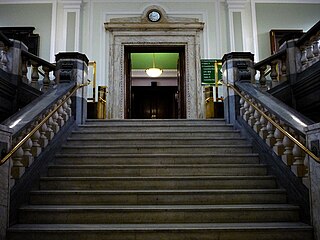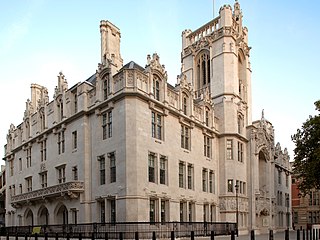
In law, a trust refers to a relationship in which the owner of property gives it to a designated entity, usually described as a trustee. The trustee has a duty to safeguard and use the assets of the trust solely for the benefit of another person or group of persons until distribution, pursuant to the provisions of the trust. In the English common law tradition, the party who entrusts the property is known as the "settlor", the party to whom the property is entrusted is known as the "trustee", the party for whose benefit the property is entrusted is known as the "beneficiary", and the entrusted property itself is known as the "corpus" or "trust property". A testamentary trust is an irrevocable trust that is established and funded pursuant to the terms of a deceased person's will. An inter vivos trust is a trust created during the settlor's lifetime.
A resulting trust is an implied trust that comes into existence by operation of law, where property is transferred to someone who pays nothing for it; and then is implied to hold the property for the benefit of another person.

In trust law, a constructive trust is an equitable remedy imposed by a court to benefit a party that has been wrongfully deprived of its rights due to either a person obtaining or holding a legal property right which they should not possess due to unjust enrichment or interference, or due to a breach of fiduciary duty, which is intercausative with unjust enrichment and/or property interference. It is a type of implied trust.

In trust law, an express trust is a trust created "in express terms, and usually in writing, as distinguished from one inferred by the law from the conduct or dealings of the parties." Property is transferred by a person to a transferee, who holds the property for the benefit of one or more persons, called beneficiaries. The trustee may distribute the property, or the income from that property, to the beneficiaries. Express trusts are frequently used in common law jurisdictions as methods of wealth preservation or enhancement.
In trust law, a beneficiary, is the person or persons who are entitled to the benefit of any trust arrangement. A beneficiary will normally be a natural person, but it is perfectly possible to have a company as the beneficiary of a trust, and this often happens in sophisticated commercial transaction structures. With the exception of charitable trusts, and some specific anomalous non-charitable purpose trusts, all trusts are required to have ascertainable beneficiaries.

Guy Anthony "Tony" Vandervell was a British industrialist, motor racing financier, and founder of the Vanwall Formula One racing team.

United States trust law is the body of law that regulates the legal instrument for holding wealth known as a trust.
Australian trust law is the law of trusts as it is applied in Australia. It is derived from, and largely continues to follow English trust law, as modified by state and federal legislation. A number of unique features of Australian trust law arise from interactions with the Australian systems of company law, family law and taxation.

English trust law concerns the protection of assets, usually when they are held by one party for another's benefit. Trusts were a creation of the English law of property and obligations, and share a subsequent history with countries across the Commonwealth and the United States. Trusts developed when claimants in property disputes were dissatisfied with the common law courts and petitioned the King for a just and equitable result. On the King's behalf, the Lord Chancellor developed a parallel justice system in the Court of Chancery, commonly referred as equity. Historically, trusts have mostly been used where people have left money in a will, or created family settlements, charities, or some types of business venture. After the Judicature Act 1873, England's courts of equity and common law were merged, and equitable principles took precedence. Today, trusts play an important role in financial investment, especially in unit trusts and in pension trusts. Although people are generally free to set the terms of trusts in any way they like, there is a growing body of legislation to protect beneficiaries or regulate the trust relationship, including the Trustee Act 1925, Trustee Investments Act 1961, Recognition of Trusts Act 1987, Financial Services and Markets Act 2000, Trustee Act 2000, Pensions Act 1995, Pensions Act 2004 and Charities Act 2011.
Kirby v Wilkins [1929] Ch 444 is a UK company law and English trusts law case involving the duties owed by a nominee of shares to the beneficiary. It determines that a beneficiary, if absolutely entitled, can instruct a bare nominee how to deal with the shares. Pending any instructions about voting from the beneficial owner, the registered holder can vote shares in the beneficiary's interest.

Re Vandervell Trustees Ltd [1974] EWCA Civ 7 is a leading English trusts law case, concerning resulting trusts.
The creation of express trusts in English law must involve four elements for the trust to be valid: capacity, certainty, constitution and formality. Capacity refers to the settlor's ability to create a trust in the first place; generally speaking, anyone capable of holding property can create a trust. There are exceptions for statutory bodies and corporations, and minors who usually cannot hold property can, in some circumstances, create trusts. Certainty refers to the three certainties required for a trust to be valid. The trust instrument must show certainty of intention to create a trust, certainty of what the subject matter of the trust is, and certainty of who the beneficiaries are. Where there is uncertainty for whatever reason, the trust will fail, although the courts have developed ways around this. Constitution means that for the trust to be valid, the property must have been transferred from the settlor to the trustees.

Resulting trusts in English law are trusts created where property is not properly disposed of. It comes from the Latin resultare, meaning to spring back, and was defined by Megarry VC as "essentially a property concept; any property that a man does not effectually dispose of remains his own". These trusts come in two forms: automatic resulting trusts, and presumed resulting trusts. Automatic resulting trusts arise from a "gap" in the equitable title of property. The equitable maxim "equity abhors a vacuum" is followed: it is against principle for a piece of property to have no owner. As such, the courts assign the property to somebody in a resulting trust to avoid this becoming an issue. They occur in one of four situations: where there is no declaration of trust, where an express trust fails, where there is surplus property, or upon the dissolution of an unincorporated association. Rules differ depending on the situation and the type of original trust under dispute; failed charitable trusts, for example, have the property reapplied in a different way from other forms of trust.
Constructive trusts in English law are a form of trust created by the English law courts primarily where the defendant has dealt with property in an "unconscionable manner"—but also in other circumstances. The property is held in "constructive trust" for the harmed party, obliging the defendant to look after it. The main factors that lead to a constructive trust are unconscionable dealings with property, profits from unlawful acts, and unauthorised profits by a fiduciary. Where the owner of a property deals with it in a way that denies or impedes the rights of some other person over that property, the courts may order that owner to hold it in constructive trust. Where someone profits from unlawful acts, such as murder, fraud, or bribery, these profits may also be held in constructive trust. The most common of these is bribery, which requires that the person be in a fiduciary office. Certain offices, such as those of trustee and company director, are always fiduciary offices. Courts may recognise others where the circumstances demand it. Where someone in a fiduciary office makes profits from their duties without the authorisation of that office's beneficiaries, a constructive trust may be imposed on those profits; there is a defence where the beneficiaries have authorised such profits. The justification here is that a person in such an office must avoid conflicts of interest, and be held to account should he fail to do so.

Westdeutsche Landesbank Girozentrale v Islington LBC[1996] UKHL 12, [1996] AC 669 is a leading English trusts law case concerning the circumstances under which a resulting trust arises. It held that such a trust must be intended, or must be able to be presumed to have been intended. In the view of the majority of the House of Lords, presumed intention to reflect what is conscionable underlies all resulting and constructive trusts.

Air Jamaica Ltd v Charlton [1999], UKPC 20, is an English trusts law case concerning resulting trusts. In this case, Lord Millett expressed the view that a resulting trust arises due to the absence of intention to benefit a recipient of money.

Chase Manhattan Bank NA v Israel-British Bank (London) Ltd [1981] Ch 105 is an English trusts law case, concerning constructive trusts. It held that a trust arose to protect a payment made under a mistake, with the benefit of a proprietary remedy. This is seen important for the question of what response, personal or proprietary, may come from a claim in unjust enrichment.

Re Vandervell Trustees Ltd [1971] AC 912 is a UK tax law case, concerning the ability of the Revenue to amend tax assessments.
Sempra Metals Ltd v Inland Revenue Commissioners [2007] UKHL 34 is a UK tax law case, concerning the availability of compound interest upon personal claims. The effect of the case, decided by a majority, was to reverse the outcome of Westdeutsche Landesbank Girozentrale v Islington LBC. However, the Supreme Court departed from this ruling in Prudential Assurance Co Ltd v Revenue and Customs Commissioners.

Akers v Samba Financial Group[2017] UKSC 6, [2017] AC 424 is a judicial decision of the Supreme Court of the United Kingdom relating to the conflict of laws, trust law and insolvency law.










